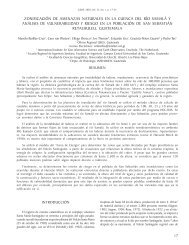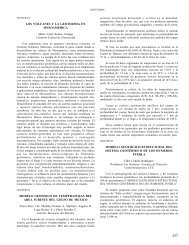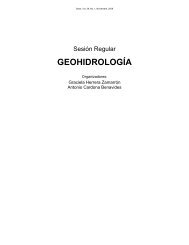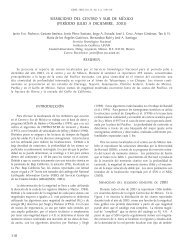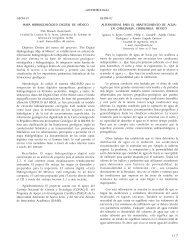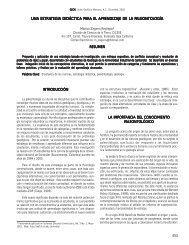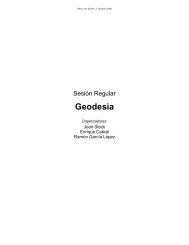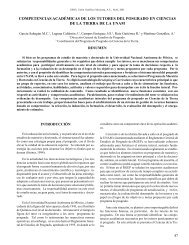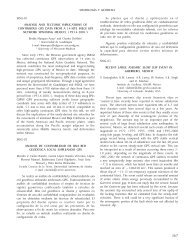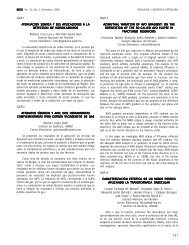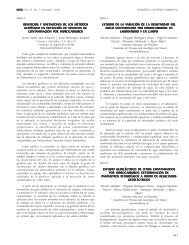Libro de Resúmenes - Unión Geofisica Mexicana AC
Libro de Resúmenes - Unión Geofisica Mexicana AC
Libro de Resúmenes - Unión Geofisica Mexicana AC
You also want an ePaper? Increase the reach of your titles
YUMPU automatically turns print PDFs into web optimized ePapers that Google loves.
GEOMAGNETISMO Y PALEOMAGNETISMO Geos, Vol. 30, No. 1, Noviembre, 2010<br />
<strong>de</strong> la susceptibilidad magnética, la cual parece ser el proxy más a<strong>de</strong>cuado para<br />
i<strong>de</strong>ntificar la influencia <strong>de</strong> tsunamis en unida<strong>de</strong>s sedimentarias.<br />
GEOPAL-19 CARTEL<br />
UNA COMPAR<strong>AC</strong>IÓN DE LOS PARÁMETROS DE ANISOTROPÍA<br />
DE SUSCEPTIBILIDAD MAGNÉTICA DE LAS BRECHAS DE<br />
IMP<strong>AC</strong>TO DEL CRÁTER DE CHICXULUB: UNAM-5 Y YAXCOPOIL-1<br />
Velasco Villarreal Miriam y Urrutia Fucugauchi Jaime<br />
Instituto <strong>de</strong> Geofísica, UNAM<br />
fatima_miriam@hotmail.com<br />
El evento <strong>de</strong> impacto <strong>de</strong>l cráter Chicxulub ocurrido hace 65.5 Ma en el<br />
límite K/Pg involucró una gran cantidad <strong>de</strong> energía que afecto toda la vida<br />
terrestre. Las etapas iniciales durante la generación <strong>de</strong>l impacto involucraron<br />
altas condiciones energéticas con presiones y temperaturas extremas <strong>de</strong><br />
<strong>de</strong>formación y fragmentación <strong>de</strong>l material <strong>de</strong>l punto <strong>de</strong> impacto (Melosh,<br />
1989). El eyecta <strong>de</strong> impacto está formado por mezclas dinámicas <strong>de</strong> material<br />
fragmentado, fundido y vaporizado <strong>de</strong>l sitio <strong>de</strong>l choque y <strong>de</strong>l bólido. Las plumas<br />
<strong>de</strong> eyecta con gases calientes y restos sólidos se expandieron a gran<strong>de</strong>s<br />
velocida<strong>de</strong>s; el colapso <strong>de</strong> la pluma <strong>de</strong> eyecta dio como resultado los <strong>de</strong>pósitos<br />
<strong>de</strong> relleno próximos, los cuales registran la información <strong>de</strong>l mecanismo <strong>de</strong><br />
transporte y condiciones <strong>de</strong> emplazamiento <strong>de</strong>l material.<br />
Para este estudio se obtuvieron muestras <strong>de</strong> la sección <strong>de</strong> impactitas <strong>de</strong>l<br />
Yaxcopoil-1 (Yax-1) (100m) y <strong>de</strong>l UNAM-5, (172 m). Los dos se localizan cerca<br />
<strong>de</strong>l centro <strong>de</strong> la estructura <strong>de</strong> impacto a ~ 62 Km y 110 Km, respectivamente.<br />
El análisis <strong>de</strong> la fábrica magnética mediante anisotropía <strong>de</strong> susceptibilidad<br />
magnética (AMS) <strong>de</strong>l eyecta <strong>de</strong> impacto muestra la complejidad <strong>de</strong>l material<br />
formado. El Yax-1 ha sido subdividido en 6 unida<strong>de</strong>s (Stoeffler et al., 2004, Kring<br />
et al., 2004, Dressler et al., 2004), El UNAM-5 ha sido subdividido en 4 unida<strong>de</strong>s.<br />
Los parámetros <strong>de</strong> anisotropía <strong>de</strong> susceptibilidad magnética (AMS) presentan<br />
algunas similitu<strong>de</strong>s y diferencias. El grado <strong>de</strong> anisotropía Pj, lo presentan bajo,<br />
<strong>de</strong>ntro <strong>de</strong>l rango <strong>de</strong> las rocas volcánicas y sedimentarias. En general A partir<br />
<strong>de</strong> los 450 m – 504 m <strong>de</strong>l las muestras <strong>de</strong>l UNAM-5, se presenta una fábrica<br />
oblada y <strong>de</strong>s<strong>de</strong> los 332-450 m, la fábrica es prolada. El Yax-1 no presenta una<br />
fábrica <strong>de</strong>finida evi<strong>de</strong>nte. La susceptibilidad magnética, K, y la NRM varían por<br />
el tipo <strong>de</strong> matriz, textura y cambios <strong>de</strong> color con la profundidad a través <strong>de</strong> la<br />
secuencia. En el UNAM-5 la susceptibilidad es menor que la <strong>de</strong>l Yax-1, mientras<br />
la intensidad <strong>de</strong> la magnetización varía entre 0.01 y 1 A/m.<br />
Consi<strong>de</strong>rando que ambos pozos están localizados cerca <strong>de</strong>l centro <strong>de</strong> la<br />
estructura, el Yax-1 <strong>de</strong>ntro <strong>de</strong>l cráter y el UNAM-5 fuera, casi en línea recta,<br />
separados aproximadamente 48 Km, es interesante observar, en primer lugar,<br />
la diferencia en la cantidad <strong>de</strong>l material <strong>de</strong> impacto, don<strong>de</strong> el UNAM-5 tiene<br />
casi el doble <strong>de</strong>l Yax-1. En general, los ejes principales en las proyecciones<br />
ortográficas, en conjunto, <strong>de</strong> cada pozo analizado no muestran una dirección<br />
<strong>de</strong>finida. Sin embargo, al separar por unida<strong>de</strong>s y estas a su vez por ejes<br />
principales, se observan ciertas distribuciones que podrían sugerir alguna<br />
dirección. La pobre <strong>de</strong>finición <strong>de</strong> las proyecciones pue<strong>de</strong> <strong>de</strong>berse al mecanismo<br />
<strong>de</strong> transporte y <strong>de</strong>pósito que hubo para cada unidad en las impactitas y a<strong>de</strong>más<br />
la distancia que existe entre cada pozo y el centro <strong>de</strong>l cráter es importante. Sin<br />
embargo hacen falta más estudios en pozos don<strong>de</strong> se presenta la brecha <strong>de</strong><br />
impacto.<br />
GEOPAL-20 CARTEL<br />
ESTUDIO DE PROPIEDADES MAGNÉTICAS EN<br />
REGOSOLES DEL VOLCÁN NEVADO DE TOLUCA<br />
Rivas Ortiz Jorge<br />
Posgrado en Ciencias <strong>de</strong> la Tierra, Instituto <strong>de</strong> Geofísica, UNAM<br />
jorger@geofisica.unam.mx<br />
El Nevado <strong>de</strong> Toluca es el cuarto volcán más alto <strong>de</strong>l país y uno <strong>de</strong> los<br />
más estudiados con diferentes métodos y diferentes enfoques. Sin embargo<br />
también es uno <strong>de</strong> las regiones con menos estudios sobre sus suelos.<br />
En este trabajo se presentan los resultados preliminares <strong>de</strong>l análisis <strong>de</strong><br />
parámetros <strong>de</strong> magnetismo <strong>de</strong> rocas en cinco perfiles <strong>de</strong> suelo ubicados en los<br />
alre<strong>de</strong>dores <strong>de</strong>l cráter. Los cinco perfiles han sido clasificados, en su unidad<br />
fundamental, como Regosoles. El objetivo <strong>de</strong>l estudio es po<strong>de</strong>r establecer<br />
la relación que existe entre los procesos pedogénicos y su comportamiento<br />
magnético, y establecer la forma en que interactúan estos con las condiciones<br />
ambientales. Los parámetros magnéticos analizados se caracterizan por la<br />
presencia y ausencia <strong>de</strong> un aumento magnético superficial (localizado solo<br />
en uno <strong>de</strong> los perfiles), y que no se habría reportado en trabajos previos<br />
realizados sobre secuencias <strong>de</strong> paleosuelos próximos al volcán. Los suelos son<br />
controlados en su mayoría por fases magnéticas suaves con poca alteración<br />
como Titano-(magnetita-maghemita), con mezclas <strong>de</strong> tamaños <strong>de</strong> partícula,<br />
y la presencia <strong>de</strong> partículas ferrimagnéticas. El comportamiento registrado<br />
en los parámetros magnéticos sugiere que las condiciones <strong>de</strong>ntro <strong>de</strong>l volcán<br />
han sido estables, con ligeras variaciones. Son procesos como crioclastia,<br />
termoclastía, acumulación, traslocación, oxidación los principales responsables<br />
<strong>de</strong> controlar la evolución <strong>de</strong>l suelo y su comportamiento magnético. Otros<br />
factores que también intervienen para la transformación <strong>de</strong> la mineralogía<br />
magnética, controlando sus tasas <strong>de</strong> alteración y distribución <strong>de</strong> tamaño <strong>de</strong><br />
partícula son el drenaje, relieve erosión e intemperismo <strong>de</strong>l suelo.<br />
GEOPAL-21 CARTEL<br />
PRELIMINARY PALEOMAGNETIC AND MICROSCOPY<br />
RESULTS OF EL JORULLO VOLCANO, MICHO<strong>AC</strong>ÁN, MÉXICO<br />
González Rangel José Antonio, Alva Valdivia Luis y Rivas Sánchez M. Luz<br />
Instituto <strong>de</strong> Geofísica, UNAM<br />
antoniog@geofisica.unam.mx<br />
Jorullo is a cin<strong>de</strong>r cone volcano in the Michoacan-Guanajuato volcanic field. It<br />
has four smaller cin<strong>de</strong>r cones which have grown from it. The vents of Jorullo are<br />
aligned in a northeast to southwest direction. Lava from these vents spread over<br />
nine square km around the volcano. Later eruptions produced lavas that had<br />
higher silica contents making them thicker than the earlier basalts and basaltic<br />
an<strong>de</strong>sites lavas. Its crater is about 400 by 500 m wi<strong>de</strong> and 150 m <strong>de</strong>ep. Jorullo<br />
was born on September 29, 1759. Its eruptions keep for 15 years. Jorullo grew<br />
250 m from the ground in the first six weeks. The eruptions were phreatic and<br />
phreatomagmatic. They covered the area with sticky mud flows, water flows and<br />
ash falls. All but the youngest lava flows were covered by this ash fall. Later<br />
eruptions were magmatic with neither mud nor water flows. This 15 year eruption<br />
was the only one Jorullo ever had, and was the longest cin<strong>de</strong>r cone eruption<br />
known. Five lava flows of these 15 year eruption period (from the base to the top)<br />
were sampled to <strong>de</strong>termine the rock magnetic properties (IRM, hysteresis, k vs.<br />
high T), optical microscopy and paleointensity of the magnetic field at that time.<br />
GEOPAL-22 CARTEL<br />
MINERALES A ESCALA NANOMÉTRICA: CAR<strong>AC</strong>TERIZ<strong>AC</strong>IÓN<br />
Y TÉCNICAS INSTRUMENTALES PARA SU ESTUDIO<br />
Rivas Sánchez M. Luz y Alva Valdivia Luis<br />
Instituto <strong>de</strong> Geofísica, UNAM<br />
mlrivass@hotmail.com<br />
El interés científico por conocer y estudiar el comportamiento inusual que<br />
presentan algunos minerales en sus propieda<strong>de</strong>s físicas y químicas motivó al<br />
<strong>de</strong>sarrollo <strong>de</strong> una ruta <strong>de</strong> investigación dirigida al estudio <strong>de</strong> minerales a escala<br />
nanométrica (tamaños menores a 50 nm), con objeto <strong>de</strong> conocer y explicar<br />
lo que no esta al alcance <strong>de</strong> una visión microscópica y penetrar a una nueva<br />
dimensión y conocimiento. La investigación inicia con el estudio por microscopia<br />
<strong>de</strong> polarización con luz transmitida y reflejada, a<strong>de</strong>más <strong>de</strong> contar con apoyo <strong>de</strong><br />
microsonda electrónica <strong>de</strong> barrido con análisis multielemental y difracción <strong>de</strong><br />
rayos X. Estos estudios son la base para la selección <strong>de</strong> muestras y su posterior<br />
estudio nanoscópico. En la caracterización <strong>de</strong> minerales a escala nanométrica<br />
se emplearon diferentes técnicas, a saber: 1) Caracterización mineralógica<br />
(cristalografía) y textural (tamaño-forma) <strong>de</strong> minerales nanoestructurados; 2)<br />
Análisis <strong>de</strong>l comportamiento inusual <strong>de</strong> nanopartículas minerales en sus<br />
propieda<strong>de</strong>s físicas, químicas y magnéticas; 3) Asociación mineralógica y<br />
textural <strong>de</strong> nanopartículas minerales; y 4) Implicaciones sobre su origen y<br />
ambiente <strong>de</strong> formación. Las técnicas nanoscópicas e instrumentales empleadas<br />
fueron: microscopia electrónica <strong>de</strong> transmisión <strong>de</strong> alta resolución, microscopia<br />
<strong>de</strong> fuerza atómica y magnética, espectroscopía <strong>de</strong> Mössbauer, espectroscopía<br />
Raman, análisis térmico diferencial y gravimétrico, ciclos <strong>de</strong> histéresis,<br />
adquisición <strong>de</strong>l magnetismo remanente isotermal, susceptibilidad magnética<br />
<strong>de</strong>pendiente <strong>de</strong> la frecuencia y <strong>de</strong> la temperatura.<br />
GEOPAL-23 CARTEL<br />
ANISOTROPY OF MAGNETIC SUSCEPTIBILITY (AMS) DATA FROM<br />
THE NEOGENE VOLCANIC SUCCESSION THAT CROP OUT IN<br />
CENTRAL SIERRA JUAREZ AND NORTHERN SIERRA LAS TINAJAS,<br />
NORTHEASTERN BAJA CALIFORNIA, MEXICO: PRELIMINARY RESULTS<br />
Mendoza Borunda Ramón, Cañón Tapia Edgardo,<br />
Suárez Vidal Francisco y Gradilla Martínez Luis Carlos<br />
Centro <strong>de</strong> Investigación Científica y <strong>de</strong> Educación Superior <strong>de</strong> Ensenada<br />
rmendoza@cicese.mx<br />
In the present work we are going to review the AMS data measured in samples<br />
from one of the largest volcanic provinces located in northern Baja California:<br />
The Sierra Juarez-Las Pintas Volcanic Province of Gastil et al. (1975). The<br />
aim of the study consist on the characterization of the magnetic petrofabric<br />
of some of the volcanic units that crop out in this area. Also, the discussion<br />
is oriented, based in the AMS parameters obtained, in relation to the source<br />
of the AMS signature, the flow direction for these volcanic <strong>de</strong>posits, and the<br />
geologic significance of the data. The collected cores for this research came<br />
from a bimodal volcanic succession of late Miocene age, composed of an<br />
extensive ignimbrite unit and few dispersed basaltic flows that crop out in<br />
central Sierra Juarez and northern Sierra las Tinajas. The former is a zoned,<br />
sheet-like pyroclastic flow <strong>de</strong>posit, composed of three distinctive members: a<br />
56


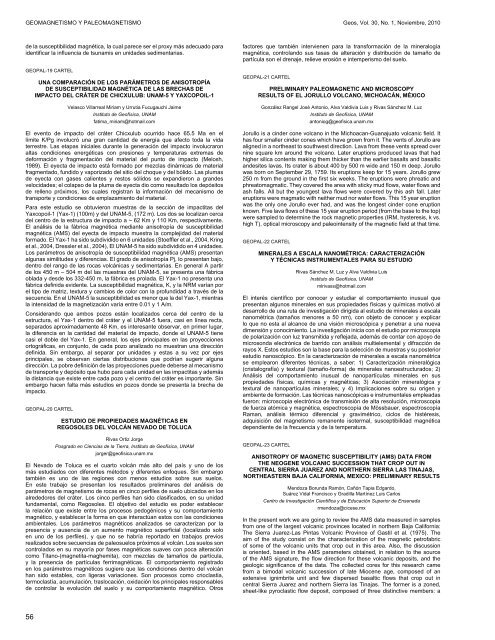
![Libro de resúmenes [revisión final, 172 páginas] - UGM](https://img.yumpu.com/51565067/1/190x245/libro-de-resamenes-revisian-final-172-paginas-ugm.jpg?quality=85)
